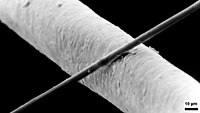
Photo from wikipedia
Abstract A facile thermal approach has been applied to recycle industrial waste into Carbon Particles (CPs). Synthesized CPs have been characterized through chemical and instrumental analysis including X-ray Photoelectron Spectroscopy… Click to show full abstract
Abstract A facile thermal approach has been applied to recycle industrial waste into Carbon Particles (CPs). Synthesized CPs have been characterized through chemical and instrumental analysis including X-ray Photoelectron Spectroscopy (XPS), Attenuated Total Reflectance (ATR), Scanning Electron Microscopy (SEM), Thermal gravimetric analysis (TGA), Differential Scanning Calorimetry (DSC), Dynamic light scattering (DLS), Cyclic Voltammetry (CV). Evaluation of CPs' conductive behavior has shown a wide range of specific capacitance from 0.977 to 102 mC, with effective electrochemical surface area from 3.49 to 359.95 cm2. A sustainable competence of CPs to carry voltage against time has also been observed. CPs upon utilization as reinforcing agents in UV-cured epoxy composites, have not only drove conductive behavior of composites but have also boosted reaction kinetics and curing conversion. Thermal stability of composites has been found increased, by incorporation of CP. DC conductivity of CP-Epoxy composites have been observed up to 5 folds higher (2.07 × 10−4 Ω−1 cm−1) than neat epoxy (4.91 × 10−9 Ω−1 cm−1).
Journal Title: Diamond and Related Materials
Year Published: 2020
Link to full text (if available)
Share on Social Media: Sign Up to like & get
recommendations!